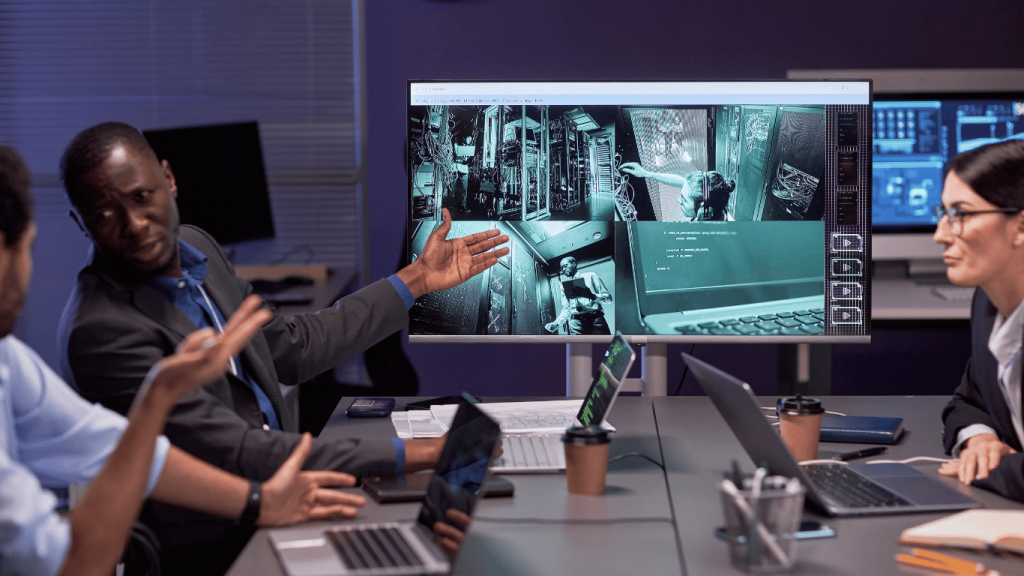Protecting your business’s sensitive information is vital. Corporate espionage and eavesdropping have become increasingly sophisticated, making Technical Surveillance Countermeasures (TSCM) (bug sweeping) an essential component of any corporate security strategy.
Let’s look at the critical role of TSCM in protecting businesses against covert surveillance and electronic eavesdropping.
What is TSCM?
TSCM, or Technical Surveillance Countermeasures, is the process of detecting and neutralising hidden surveillance devices, such as bugs, hidden cameras, and GPS trackers. In the corporate world, where private conversations and sensitive information are valuable commodities, TSCM plays a crucial role in maintaining confidentiality and preventing corporate espionage.
Why Do Businesses Need Bug Sweeping Services?
With the advancement of technology, eavesdropping devices have become smaller, more sophisticated, and easier to conceal. A single compromised meeting room or executive office could lead to devastating consequences, including:
- Loss of intellectual property
- Damage to reputation
- Financial losses
- Legal ramifications
- Competitive disadvantage
By incorporating regular office bug sweeps into their security protocols, businesses can protect themselves against these threats and ensure the integrity of their private conversations and sensitive data.
How Do Corporate Bug Sweeps Work?
A professional bug sweep service involves a thorough inspection of the premises using specialised equipment to detect various types of bugging devices. The process typically includes:
1. Visual Inspection
The bug sweep process begins with a meticulous visual inspection of the premises. Trained technicians thoroughly examine the area, looking for any signs of tampering, unusual modifications, or suspicious objects that could indicate the presence of hidden spying devices.
2. Electronic Sweeps
Following the visual inspection, advanced electronic sweeps are conducted. Experts use bug detectors and spectrum analysers to scan for radio frequency (RF) transmissions, which could suggest the presence of wireless bugs or hidden cameras. This step is essential for identifying any devices that may be transmitting signals from within the area.
3. Non-Linear Junction Detection
Non-linear junction detection is employed to further enhance detection. This technique helps identify electronic components that may be part of a surveillance device, even if they are not currently transmitting. It’s particularly useful for locating hidden circuits and semiconductors within walls, furniture, or other objects.
4. Thermal Imaging
Thermal imaging is then used to detect heat signatures that might reveal the presence of hidden electronic devices. This method is effective in finding devices that generate heat, such as active bugs or transmitters, even if they are concealed within structures.
5. Physical Search
In some cases, a physical search of the premises is necessary. Technicians may need to partially dismantle furniture, fixtures, or other elements of the environment to check for well-hidden devices. This hands-on approach ensures that no area is left unchecked.
6. Wi-Fi and Network Analysis
A thorough analysis of the local Wi-Fi and network infrastructure is also conducted. Experts examine the network for any unauthorised devices or suspicious activity, which could indicate that a device has been introduced to monitor communications or data flow.
7. Mobile Phone Forensics
Lastly, mobile phone forensics is performed to check company phones for signs of compromise or unauthorised monitoring software. This step helps ensure that mobile devices, which are often targeted in surveillance efforts, are secure and free from any breaches.
When Should Businesses Consider Professional Bug Sweeping Services?
There are several scenarios where corporate bug sweeping becomes particularly crucial:
- Before and after important meetings or negotiations
- When entering new office spaces or renovating existing ones
- Following a security breach or suspected information leak
- Prior to major product launches or announcements
- During mergers and acquisitions
- When hosting high-profile clients or visitors
- Regularly as part of ongoing security protocols
How Can Businesses Ensure Effective TSCM Implementation?
Businesses should consider the following practices to maximise the effectiveness of TSCM in corporate security strategies:
- Regular sweeps – Schedule periodic bug sweeps to maintain a secure environment.
- Employee training – Educate staff about the risks of eavesdropping and how to identify suspicious devices or behaviour.
- Access control – Implement strict policies regarding who can enter sensitive areas of the office.
- Vendor vetting – Carefully screen all contractors and service providers who have access to your premises.
- Secure communication protocols – Establish guidelines for discussing sensitive information, including the use of secure communication channels.
- Physical security measures – Implement comprehensive physical security to prevent unauthorised access to your premises.
- Incident response plan – Develop a clear protocol for responding to discovered surveillance devices.
How Does TSCM Fit into a Broader Corporate Security Strategy?
While TSCM is a crucial component of corporate security, it should be part of a broader, multi-layered approach. This comprehensive strategy might include:
- Cybersecurity measures
- Physical security protocols
- Employee background checks
- Information security policies
- Regular security audits
- Incident response planning
- Ongoing security awareness training
By integrating TSCM with these other security measures, businesses can create a comprehensive defence against various forms of corporate espionage and information theft.
Advanced Sweeping: Protecting Modern Businesses
TSCM plays a vital role in protecting businesses against the ever-present threat of covert surveillance and eavesdropping. By incorporating regular bug sweeps and maintaining a strong counter surveillance posture, companies can protect their intellectual property, maintain their competitive edge, and ensure the privacy of their operations.
For businesses in the UK seeking to enhance their security posture, Advanced Sweeping offers comprehensive TSCM services tailored to meet the unique needs of corporate clients. Our expert team utilises cutting-edge equipment to detect and neutralise a wide range of surveillance devices, providing peace of mind and ensuring the integrity of your sensitive information.
Don’t leave your corporate security to chance. Contact us today to learn more about our discreet corporate bug sweeping services and how we can help protect your business from the threats of corporate espionage and covert surveillance.
